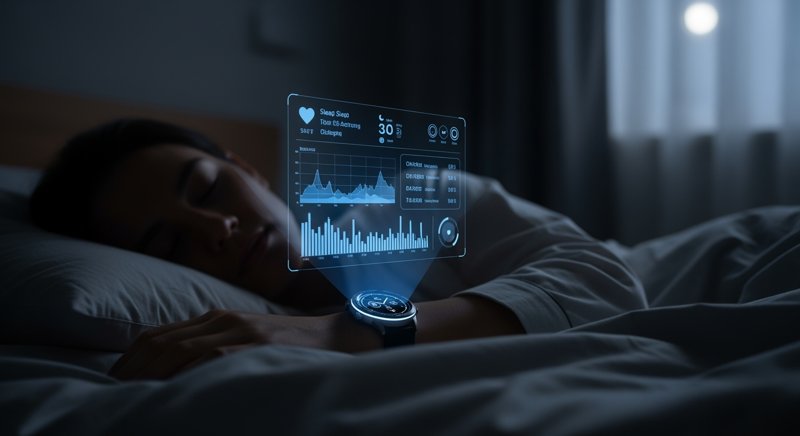😴 The Smart Sleep Checklist: A 14-Day, Data-Driven Guide to Rebooting Your Sleep

It’s one of the most frustrating paradoxes of modern life: you spend a full eight hours in bed, yet you wake up feeling unrestored, foggy, and as if you’ve barely slept at all. This gap between sleep quantity and sleep quality is a sign that your sleep architecture is compromised. The good news is that it’s fixable.
This is not a guide about chamomile tea or counting sheep. This is a two-week, data-driven experiment to become the CEO of your own sleep. By systematically tracking key metrics and making targeted interventions, you can identify the hidden saboteurs of your rest and rebuild your sleep from the ground up.
The Science of Sleep: A Quick Primer
Two primary forces govern your sleep:
- Sleep Pressure (Process S): Throughout the day, a molecule called adenosine builds up in your brain as a byproduct of energy consumption. The more adenosine, the higher the “sleep pressure” and the sleepier you feel.
- Circadian Rhythm (Process C): This is your 24-hour internal clock, orchestrated by a master pacemaker in your brain called the suprachiasmatic nucleus (SCN). It’s primarily regulated by light exposure.
Optimal sleep occurs when these two forces are perfectly synchronized: you have high sleep pressure, and your circadian clock is signaling that it’s nighttime.
Week One: The Data Collection Phase
For the first seven days, your only job is to be a detective. Don’t try to “fix” anything yet. Just gather the data to understand your baseline.
Your Toolkit:
- A Subjective Log: Each morning, note your “lights out” time, how long it took to fall asleep, any awakenings, and your wake-up time. Rate your morning energy and mood on a scale of 1-10. Also, log key variables from the previous day: timing of your last meal and last caffeine, alcohol intake, and evening stress levels.
- A Wearable Device: A smartwatch or smart ring is invaluable for tracking objective trends in:
- Resting Heart Rate (RHR): A healthy sleep pattern shows a dip in RHR shortly after you fall asleep, reaching its lowest point (the “nadir”) around the middle of the night.
- Heart Rate Variability (HRV): A measure of the variation in time between your heartbeats. A higher overnight HRV is a strong indicator of good recovery and a relaxed nervous system.
What to Look For:
Each morning, compare your subjective feelings to your objective data. Did that late-night snack cause your RHR to stay elevated all night? Did an evening argument correlate with a crash in your HRV? These patterns are the clues you’ll use in week two.
Week Two: The Intervention Phase
Armed with a week of data, it’s time to systematically eliminate the most common sleep saboteurs.
1. Master Your Adenosine: The Caffeine Curfew
- The Science: Caffeine is an adenosine antagonist. It works by blocking the adenosine receptors in your brain, effectively masking the sleep pressure that has been building all day. With a half-life of 5-7 hours, a 3 PM coffee can still be blocking half of your adenosine receptors at 8 PM.
- The Protocol: Institute a strict caffeine curfew at 2 PM. This gives your body ample time to clear the caffeine and allow natural sleep pressure to build.
2. Anchor Your Circadian Rhythm: The Power of Light
- The Science: Your circadian clock is most powerfully influenced by the timing of light exposure.
- The Protocol:
- Morning Sunlight: Within 30-60 minutes of waking, get 10-15 minutes of direct, natural sunlight. This is the most powerful signal you can send to your brain to start the 24-hour timer.
- Evening Darkness: In the last 2-3 hours before bed, dim the lights in your home and avoid bright overhead lighting. This allows the sleep-inducing hormone melatonin to rise naturally. Wear blue-light blocking glasses if you must be on a screen.
3. Respect Your Thermoregulation
- The Science: To initiate and maintain sleep, your body’s core temperature needs to drop by about 1-2 degrees Celsius.
- The Protocol:
- Cool Your Room: The ideal sleep temperature is a cool 18-20°C (65-68°F).
- A Hot Bath/Shower: Taking a hot bath or shower 90 minutes before bed can paradoxically help you cool down. The hot water draws blood to the surface of your skin, and when you get out, the rapid cooling of your skin sends a powerful “time for sleep” signal to your brain.
4. Protect the Glymphatic System
- The Science: During deep sleep, a remarkable process called the glymphatic system activates. It’s essentially the brain’s cleanup crew, flushing out metabolic waste products that accumulate during the day, including amyloid-beta, the protein associated with Alzheimer’s disease. This system works best during deep, uninterrupted sleep.
- The Protocol:
- Avoid Late-Night Meals: A large meal close to bedtime can raise your core body temperature and heart rate, disrupting the deep sleep stages necessary for glymphatic clearance. Finish your last meal at least 3 hours before bed.
- Eliminate Alcohol: While alcohol may feel like a sedative initially, its metabolism during the night causes a “rebound” effect, fragmenting sleep and severely suppressing the deep and REM stages.
The Final Analysis
At the end of week two, compare your data. Did your RHR start to show a clear downward curve? Did your HRV trend upward? Do you feel more rested and energized in the morning?
This two-week experiment is a powerful tool for self-discovery. It allows you to move beyond generic sleep advice and build a personalized protocol based on your own data. Sleep is your most potent tool for physical and mental performance. It’s time to start treating it like one.

